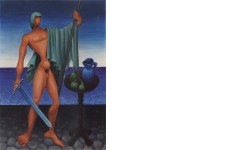Ελαιογραφία 249Μικτή Τεχνική 357Σχέδιο 293Αυγοτέμπερα 77Τέμπερα 132Ακρυλικά 1Παστέλ 1Gouache 2Υδατογραφία 34Χαρακτική 1
Ειδικές Πληροφορίες για τον Καλλιτέχνη
TITΛΟΣ ΕΡΓΟΥΦΙΛΟΠΟΙΜΗΝ
ΔΙΑΣΤΑΣΕΙΣ ΕΡΓΟΥΎψος : 70
Πλάτος : 50
ΥΛΙΚΟ ΚΑΤΑΣΚΕΥΗΣΕλαιογραφία (Λάδι σε καμβά)
ΥΠΟΓΡΑΦΗ ΚΑΛΛΙΤΕΧΝΗΚάτω Δεξιά
ΧΡΟΝΟΛΟΓΗΣΗ01-01-1957 - 01-01-1957
ΕΛΕΓΧΟΣ ΓΝΗΣΙΟΤΗΤΑΣΔεν έχει ελεγχθεί

Provenance:
Private collection, Athens.
A most distinctive work by Nikos Engonopoulos, up until now available to scholarly research only through a charcoal and pencil on paper published in
Nikos Engonopoulos, Sketches and Colours Athens 1996 (fig. 51). Katerina Perpinioti-Agazir, who is preparing the artists catalogue raisonné, holds that the picture offered at auction might have been shown during the 5th Panhellenic Exhibition at the Zappeion Hall in May 1957 (no. 100), under the title
Philopoemen (compare Philopoemen, David d'Angers, 1837, Louvre).
This splendid canvas is an artistic vision which alludes to collective cultural symbols drawn from Greek mythology and the heroism of a bygone era, faithfully reflecting the artists attitude towards painting, both as a long and rich tradition to draw from, as well as an ideal vehicle to probe into the inner world of Greekness. Engonopoulos gave us one version of surrealism, universal, but at the same time deeply rooted in Greekness, notes the art historian N. Loizidi.1
An eminent 20th century artist and a pioneering advocate of surrealism, N. Engonopoulos placed Greek mythology at the base of his thematic pyramid. He did not attempt, however, a so-called return to the roots, as did the majority of the artists of his generation. He did not approach mythology with an obsession for antiquity or with nostalgia, but rather as equal to equal. He depicted the impact of myths in his time, revealing their subversive, dreamlike and erotic components. His artistic world is unique and recognizable, fashioned with striking colours, in which his sensual, faceless figures, with an enigmatic motionlessness and/or hieratic gestures, are usually positioned in irrationally structured settings and surrounded by various heterogeneous objects.2
All these defining features of Engonopoulos art are amply demonstrated in Hero: the bright blues and greens, which he handles with conscious daring, unique aptitude and undisputed love, inviting the viewer to a festive ritual of pure colour3; the epic and heroic expression which seems to glorify an unknown event of lofty national exaltation, echoing the didactic description of Byzantine icon painting and the high rhetoric of his beloved teacher Constantinos Parthenis4; the unexpected presence of a still life with pears and pitcher, which recalls his emblematic 1936 Still life; and, finally, the phantom-like mannequin figure that introduces the viewer to an enigmatic system of poetic metaphor. I love the nude body more than the face the artist himself noted in an interview. The face may lie. The nude never does. Thats why I am not interested in the face. Its only the body that I paint. I love it because it is the chalice of life. As expressive as life is, even when tired. As sparkling as life is, when young.5
1. N. Loizidi, Surrealism in Modern Greek Art [in Greek], Athens 1984, p. 181.
2. K.Perpinioti-Agazir, Nikos Engonopoloulos, Mythology, Ypsilon ed., Athens 2006, p. 10, 17.
3. See S. Boulakian, The Work of Nikos Engonopoulos in Greek Painters-20th Century [in Greek], Melissa publ., Athens 1974, p. 262.
4. See A. Kafetsi, Stage Setting Paradoxes of N. Engonopoulos [In Greek], Hartis review, no 25/26, November 1988, p.48.
5. Apogevmatini daily, 2.8.1969.